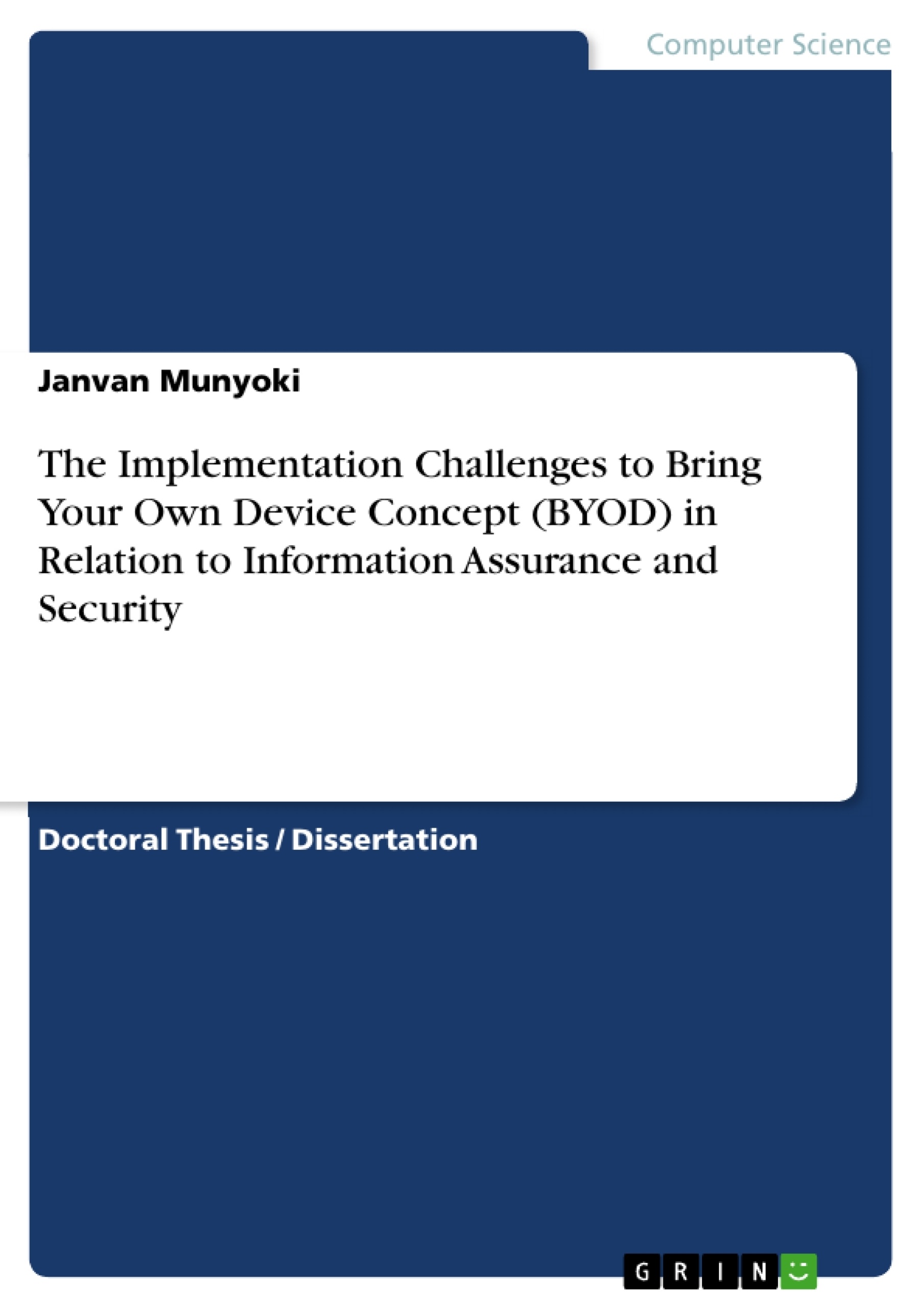Research conducted by Tech Pro (2014) indicated that the Bring Your Own Device (BYOD) concept is gaining momentum, with 74% of organizations already having some BYOD program or planning to implement one. While BYOD offers several benefits, it also presents challenges that concern information technology leaders and information security managers.
This correlational study used the systems theory framework to examine the relationship between information security managers’ intentions, perceptions of security, and compliance regarding BYOD implementation. Participants of the study consisted of information security managers in Kenya who had obtained the Certified Information Systems Manager certification. Data was collected from 54 information security managers through a survey instrument. The survey instrument integrated three other instruments with proven reliability developed by other researchers.
Data was analyzed using a multiple regression analysis to test for a relationship between the variables of the study (security, compliance, and intent to implement BYOD). The multiple regression conducted in this study was insignificant, indicating a relationship did not exist between the study’s variables (F(2, 86) = 0.33, p = .718, R2 = .00). A significant negative relationship was found between security and compliance, indicating a weakly negative correlation (r = -.26, p = .016).
Using the results from the study, information technology leaders may be able to develop strategies from which to implement BYOD successfully. Implications for social change include increased knowledge of securing personal devices for employees and consumers in general and reduction in costs associated with security and data breaches.
Inhaltsverzeichnis (Table of Contents)
- Abstract
Zielsetzung und Themenschwerpunkte (Objectives and Key Themes)
This doctoral study examines the challenges of implementing Bring Your Own Device (BYOD) programs in relation to information assurance and security. The research aims to understand the relationship between information security managers' intentions, perceptions of security, and compliance regarding BYOD implementation.
- Challenges of BYOD implementation
- Information security management in BYOD contexts
- Relationship between security perceptions, compliance, and intention to implement BYOD
- Strategies for successful BYOD implementation
- Implications for securing personal devices and reducing costs associated with security breaches
Zusammenfassung der Kapitel (Chapter Summaries)
Abstract: This correlational study investigated the relationship between information security managers' intentions, perceptions of security, and compliance concerning BYOD implementation. Utilizing a systems theory framework and data from 54 Kenyan Certified Information Systems Managers, a multiple regression analysis revealed no significant relationship between the variables (F(2, 86) = 0.33, p = .718, R² = .00). However, a significant negative correlation was found between security and compliance (r = -.26, p = .016), suggesting a weak inverse relationship. The study's findings offer insights for developing strategies to successfully implement BYOD programs and highlight implications for improving employee and consumer device security, ultimately reducing costs related to data breaches. The study is based on data from a survey instrument integrated with three other proven reliability instruments, focusing on a specific population of certified information systems managers in Kenya. The lack of significant relationship between the primary variables is a key finding that requires further exploration.
Schlüsselwörter (Keywords)
Bring Your Own Device (BYOD), information security, information assurance, security management, compliance, correlational study, multiple regression analysis, systems theory, Kenya, Certified Information Systems Manager.
Frequently Asked Questions: Doctoral Study on BYOD Implementation in Kenya
What is the main focus of this doctoral study?
This doctoral study examines the challenges of implementing Bring Your Own Device (BYOD) programs in relation to information assurance and security in Kenya. It investigates the relationship between information security managers' intentions, perceptions of security, and compliance regarding BYOD implementation.
What are the key themes explored in the research?
The key themes include the challenges of BYOD implementation, information security management in BYOD contexts, the relationship between security perceptions, compliance, and intention to implement BYOD, strategies for successful BYOD implementation, and implications for securing personal devices and reducing costs associated with security breaches.
What methodology was used in this study?
This was a correlational study utilizing a systems theory framework. Data was collected from 54 Kenyan Certified Information Systems Managers. A multiple regression analysis was employed to examine the relationship between the variables.
What were the key findings of the multiple regression analysis?
The multiple regression analysis revealed no significant relationship between information security managers' intentions, perceptions of security, and compliance concerning BYOD implementation (F(2, 86) = 0.33, p = .718, R² = .00). However, a significant negative correlation was found between security and compliance (r = -.26, p = .016), suggesting a weak inverse relationship.
What are the implications of the study's findings?
The findings offer insights for developing strategies to successfully implement BYOD programs and highlight implications for improving employee and consumer device security, ultimately reducing costs related to data breaches. The lack of a significant relationship between the primary variables necessitates further exploration.
What is the target population of this study?
The study is based on data from a survey instrument administered to a specific population of 54 certified information systems managers in Kenya. The survey instrument was integrated with three other proven reliability instruments.
What are the keywords associated with this research?
Bring Your Own Device (BYOD), information security, information assurance, security management, compliance, correlational study, multiple regression analysis, systems theory, Kenya, Certified Information Systems Manager.
Where can I find a more detailed summary of the study?
A comprehensive chapter summary, including the abstract, is provided within the full text of the study.
- Citar trabajo
- Janvan Munyoki (Autor), 2016, The Implementation Challenges to Bring Your Own Device Concept (BYOD) in Relation to Information Assurance and Security, Múnich, GRIN Verlag, https://www.grin.com/document/1324291



